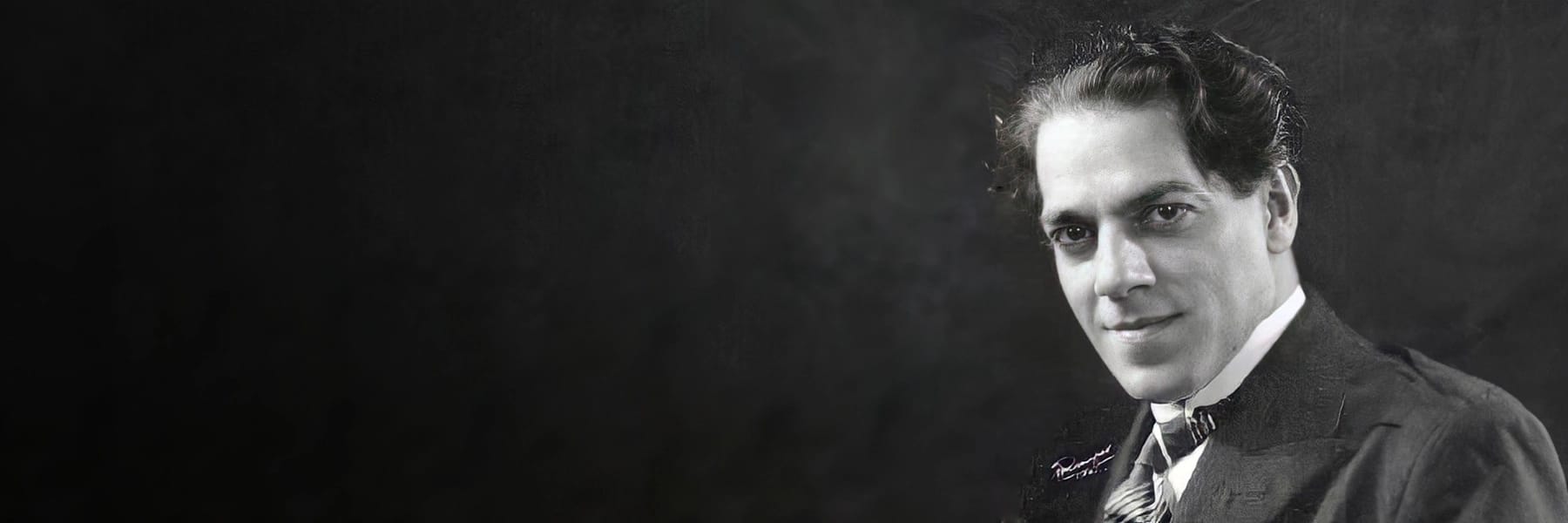
articles / Pop Culture
10 Composers From Across Latin America We’re Celebrating This Month!
In honor of Hispanic Heritage Month, here are 10 composers you should know!
Teresa Carreño (1853–1917)

Teresa Carreño in 1916
Venezuelan composer Teresa Carreño was a pianist of remarkable technical ability who began her performing career as a child, playing for President Abraham Lincoln when she was about ten years old in 1863. Due to ongoing political instability in Venezuela, she spent the majority of her life abroad, living mainly in New York and then Berlin in her later years. She toured constantly throughout the Americas, Europe, Africa, and Australia. Known for her virtuosic style of piano writing, she often incorporated the dance rhythms of her home country into her music, such as the danza and valse criollo. Listen to her Ballade, Op. 15:
Ricardo Castro (1864–1907)

Ricardo Castro
Born in Durango, Mexico, Ricardo Castro was a composer and gifted pianist who initially gained recognition as a brilliant performer of Chopin and Liszt. He received a scholarship from the Mexican government to present master classes at conservatories in Paris, Brussels, Rome, Milan, and Leipzig. While in Paris, he studied under Teresa Carreño. He was known for piano works written in a florid style and wrote the first known classical piano concerto and cello concerto to emerge from Mexico.
Manuel Ponce (1882–1948)
Born near Aguascalientes, Mexico, Manuel Ponce was a pianist and composer who brought Mexican folk traditions to the concert hall and contributed significantly to defining a Mexican national style. As a child, he began studying music by sitting in on his sister Josefína’s piano lessons. Following studies in Italy and Germany, Ponce returned to Mexico City to teach piano and music history at the National Conservatory of Music. He first received international exposure with the song Estrellita (1912), which was sung by numerous vocalists and adapted for violin. In addition to a sizeable collection of songs, Ponce’s guitar music remains a staple of the repertoire.
Agustín Barrios (1885–1944)

Barrios poses with his guitar in 1910
Agustín Barrios was a Paraguayan and Guarani virtuoso guitarist who is considered to be one of the most prolific composers for the guitar. He was a precocious child who loved music and literature, and spoke fluent Spanish and Guarani. He also read English, French, and German. At fifteen, he became one of the youngest college students in Paraguayan history, attending the Colegio Nacional de Asunción. He performed and recorded widely across South America and Europe, often wearing traditional Guarani dress in honor of his indigenous heritage. Barrios was also an important pedagogue, maintaining a close-knit studio of twelve students, mostly of Salvadorean nationality, whom he instructed in his methods and techniques. Enjoy his Vals Op.8, No. 3, brilliantly played by Raphaël Feuillâtre:
Heitor Villa-Lobos (1887–1959)

Villa-Lobos in 1922
Heitor Villa-Lobos was a Brazilian composer, conductor, cellist, and guitarist who blended Brazilian folk music with Western classical forms. He had little in the way of formal training, instead learning music by listening at the top of the stairs during the musical soirées his father hosted. Villa-Lobos’s compositions span a wide range of genres, including orchestral, chamber, instrumental, and vocal pieces. His works are characterized by vibrant rhythms, lush harmonies, and a deep connection to Brazilian landscapes and folklore. His Bachianas Brasileiras and Chôros are among his most celebrated compositions. Listen to a movement from Bachianas Brasileiras:
Ernesto Lecuona (1896–1963)

Lecuona circa 1935
Ernesto Lecuona was a Cuban pianist and composer who melded Afro-Cuban rhythms and popular melodies with virtuosic piano writing. He received first prize and a gold medal from the National Conservatory in Havana, graduating in 1913. In the 1930s, he became the leader of a popular dance band, the Lecuona Cuban Boys, that toured Latin America, Europe, and the United States. In addition to composing big band and concert music, he wrote numerous songs for stage, screen, and radio, scoring The Cuban Love Song, Always in My Heart, and Carnival in Costa Rica. One of his hit songs, “Always in My Heart” (1942), was nominated for an Oscar for best song, but lost to Irving Berlin’s “White Christmas.” Listen to pianist Thomas Tirino perform “Always in My Heart”:
Sofía Cancino de Cuevas (1897–1982)
According to researcher Alejandro Duprat, Sofía Cancino may have been the first known female Mexican composer to have written a symphony. Cancino grew up in Mexico City and began teaching piano at 22 at the Pedro Luis Ogazón Academy. She studied voice with Consuelo Escobar de Castro and composition with Rafael J. Tello, Manuel Ponce, and Julián Carrillo at the National Autonomous University of Mexico. Cancino made her debut as a pianist in 1937, performing Mozart’s Piano Concerto No. 26, and also sang mezzo-soprano roles in various operas. She wrote nearly 100 works over the course of her life, composing numerous chamber and vocal works as well as several symphonies and at least four operas. Many of her works seem to be inspired by the classical era and feature beautiful, flowing melodies and an exquisite sense of proportion and counterpoint. Regrettably, the majority of her works remain unpublished but are gradually becoming more widely known. Here’s the first movement of her string quartet, “Las Damas de la Música”:
Astor Piazzolla (1921–1992)

Astor Piazzolla playing the bandonéon, photographed by Eduardo Comesaña
A prodigy on the bandonéon, a type of accordion, Argentine composer and bandleader Astor Piazzolla pioneered “nuevo tango,” an avant-garde take on the tango that included extreme dissonance and borrowed elements from jazz and classical music. He cut his teeth producing tango arrangements for Aníbal Troilo and studied classical music with Alberto Ginastera. In 1954, he composed a symphony for the Buenos Aires Philharmonic Orchestra, winning a scholarship to study under Nadia Boulanger, who encouraged his tango compositions. Piazzolla returned to Argentina to form several influential tango ensembles. Although it was initially shunned by his peers, Piazzolla’s music gained traction abroad, especially in the United States and France. By the 1980s, his music finally found favor in his home country, where he was hailed as an innovator. Enjoy Piazzolla’s Oblivion:
Tania Léon (b. 1943)

Tania León is recognized for her achievements at the Kennedy Center Honors in 2022. U.S. Department of State from United States, Public domain, via Wikimedia Commons.
Composer, conductor, and educator Tania León was born in Havana Cuba in 1943. She studied at the Conservatorio de Música in Havana and began her career as a pianist, emigrating to the United States in 1967. After composition studies at NYU, she became a founding member and the first Music Director of the Dance Theatre of Harlem, serving as a pianist, conductor, and composer there. In 1977, she founded the Community Concert Series at the Brooklyn Philharmonic Orchestra, later becoming its associate conductor. She has also served as a consultant for new music to the New York Philharmonic and founded Composers Now, an organization devoted to promoting the work of living composers. In 2021, she was awarded the Pulitzer Prize in Music for her orchestral work Stride, written in honor of the women’s voting rights activist Susan B. Anthony and commissioned by the New York Philharmonic. Listen to an excerpt of Stride here:
Gabriela Ortiz (b. 1964)
Born in Mexico City in 1964, Gabriela Ortiz has garnered international acclaim for her innovative compositions, which fuse elements of Mexican folk music, jazz, and high art music. She studied at the National Conservatory of Music in Mexico, Guildhall School of Music and Drama, and the City University in London, where she received a doctorate in composition in 1996. Her works often explore social and political themes, such as her opera Ana and her Shadow (2013), on the experience of Mexican migrants in America. Ortiz has enjoyed a fruitful partnership with the Los Angeles Philharmonic, who premiered her Yanga as part of its centennial celebration in 2019. Incorporating a chorus as well as African instruments, Yanga traces the life of Gaspar Yanga, the African leader of a group of escaped slaves who successfully resisted the Spanish and founded a maroon colony near Veracruz, Mexico in the early 17th century. Listen to excerpts from Yanga here:






